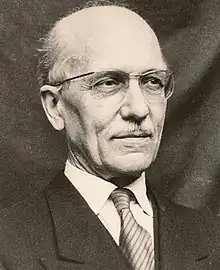
Jean François Orcel (3 May 1896 – 27 March 1978) was a French mineralogist who contributed to the French nuclear energy program following the discovery of Uranium vanadate deposits in Morocco. He served as a mineralogist at the Muséum National d’Histoire Naturelle in Paris. He later specialized in the chemistry of meteorites.
Biography
Orcel was born in Paris where his father Edouard was a public works engineer. His mother Pauline Lesuisse was a teacher. After studies at the Lycée Henri IV he went on to study at Sorbonne even though World War I broke out as poor health disqualified him from conscription. He became an assistant to Frédéric Wallerant in 1917 and in 1920 he joined the Muséum National d’Histoire Naturelle working under Alfred Lacroix. After Lacroix's retirement in 1937, Orcel succeeded him as professor of mineralogy. Orcel studied phyllosilicates and chlorites, examining water of crystallization in his doctoral work. He also went on field expeditions, collecting minerals and developing geological maps. He was involved in the acquisition of the mineral collection of Colonel Louis Vésigné (1870-1954).[1] He examined the optical properties and polarization of minerals including methods for dealing with opaque minerals. During World War II he was involved in the resistance and in protecting the precious holdings of the museum. Following the war, he was involved in prospecting for uranium salts along with Louis Barrabé of which were found in Morocco. After retirement, he took an interest in meteorite chemistry. A mineral of nickel arsenate was named as Orcelite by his student Simone Caillère in 1959. He also worked with the meteorite researcher Elisabeth Jeremine (1879-1964).[2][3][4]
Global policy
He was one of the signatories of the agreement to convene a convention for drafting a world constitution.[5][6] As a result, for the first time in human history, a World Constituent Assembly convened to draft and adopt the Constitution for the Federation of Earth.[7]
References
- ↑ Caillet Komorowski, Catherine L.V. (2006). "The meteorite collection of the National Museum of Natural History in Paris, France". Geological Society, London, Special Publications. 256 (1): 163–204. Bibcode:2006GSLSP.256..163C. doi:10.1144/GSL.SP.2006.256.01.09. ISSN 0305-8719. S2CID 219202325.
- ↑ Orcel, Jean (1965). "Elisabeth Jeremine (1879-1964)". Bulletin de la Société Géologique de France. S7-VII (4): 608–614. doi:10.2113/gssgfbull.S7-VII.4.608. ISSN 1777-5817.
- ↑ Caillère, S.; Avias, J.; Falgleirettes, J. (1959). "Découverte en Nouvelle-Calédonie d'une minéralisation arsenicale sous forme d'un nouvel arséniure de nickel Ni, As". Comptes Rendus Hebdomadaires des Séances de l'Académie des Sciences. 249: 1771–1773.
- ↑ Caillère, Simonne (1979). "Jean Orcel, 1896–1978". Bulletin de minéralogie (in French). 102: 303–305.
- ↑ "Letters from Thane Read asking Helen Keller to sign the World Constitution for world peace. 1961". Helen Keller Archive. American Foundation for the Blind. Retrieved 2023-07-01.
- ↑ "Letter from World Constitution Coordinating Committee to Helen, enclosing current materials". Helen Keller Archive. American Foundation for the Blind. Retrieved 2023-07-03.
- ↑ "Preparing earth constitution | Global Strategies & Solutions | The Encyclopedia of World Problems". The Encyclopedia of World Problems | Union of International Associations (UIA). Retrieved 2023-07-15.